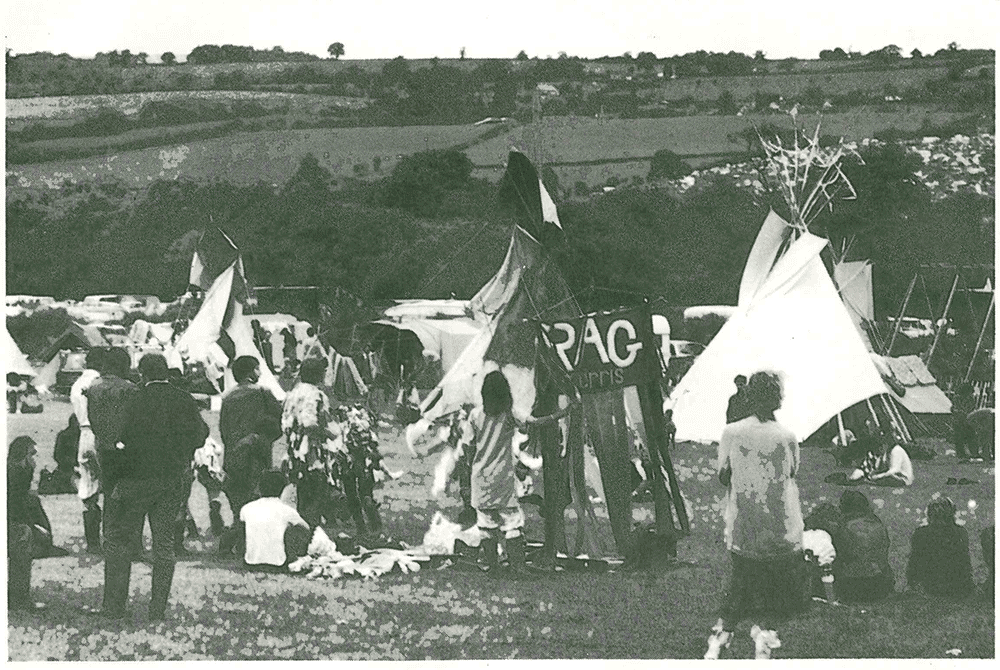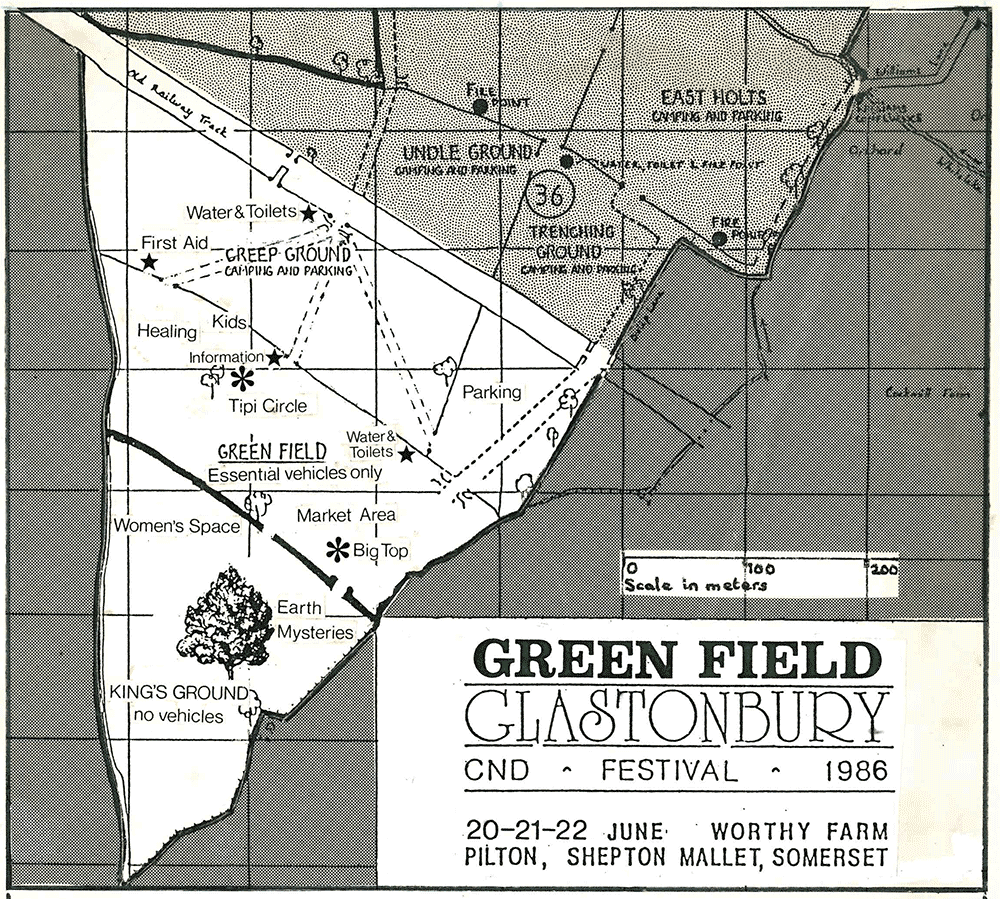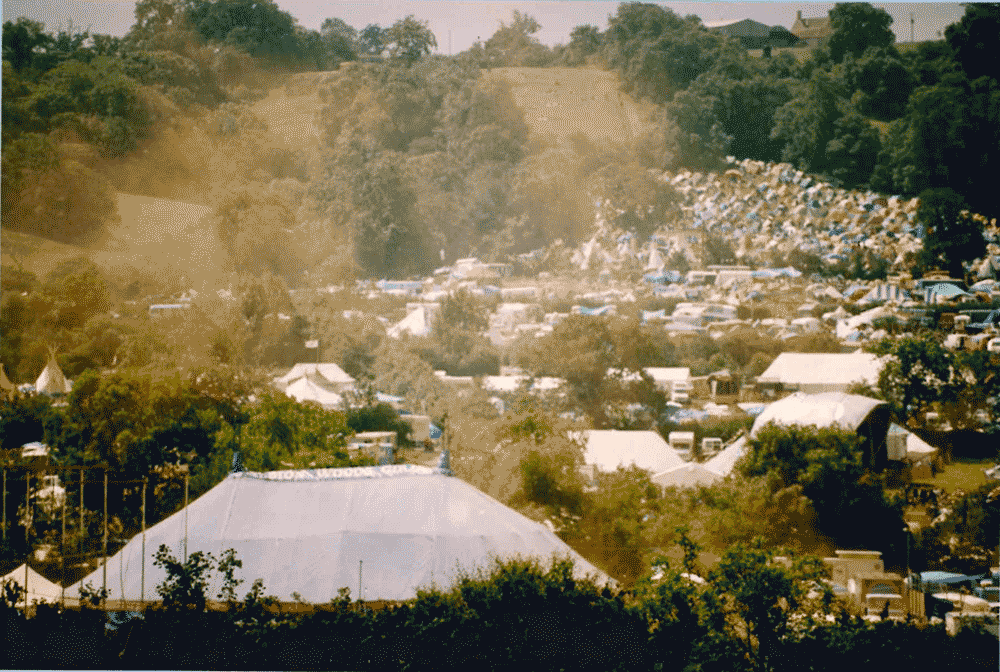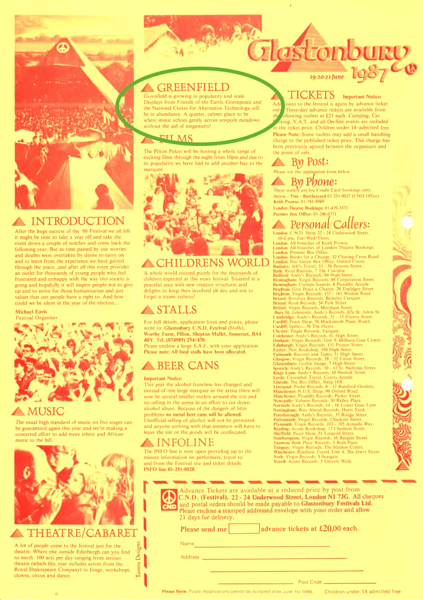The Green Collective and its part in creating the Green Fields at Glastonbury Festival
The role of the Green Collective in making the Green area a major part of Glastonbury Festival’s geography is something that is barely remembered now; nor are its humble beginnings in Norman’s Close (now used as the children’s field). This was in 1984. At the time the Green Field was very different from the rest of the festival and it attracted real interest from visiting TV film crews. As a result of its success it grew rapidly from year to year and soon took up most of the new land above the railway line that was added to the site in 1985.
The Green Collective was the group that had been organising the early Green Gatherings, which took place at Worthy Farm from 1980 to 1982. The Green Field story really begins in 1983, when Michael Eavis reluctantly asked the Gathering to move, but approached his friend Teddy Stone, who lived close by and agreed to host the event at Lamberts Hill Farm (near Shepton Mallet). Michael had been under pressure from Mendip District Council, who were looking for excuses to close the festival down. They had made it clear that additional smaller events at Worthy Farm would count against him.
The 1983 Green Gathering went ahead at Lamberts Hill, and all may have been well except that the large group of travellers known as ‘the convoy’ arrived just as the event was getting underway. They had been subjected to very heavy policing at Inglestone Common in Gloucestershire, and arrived on the Gathering site looking for a safe haven – but they brought with them half of Somerset’s police force. This all led to much bad publicity, and the resulting ‘turbulence’, as the Collective’s Mailing called it, not only put unwanted pressure on Teddy Stone, but also prompted the Council to prosecute Michael for breach of the licensing conditions at his festival.
This was the first year that local authorities had been given the power to issue licences for festivals. The Green Gathering was a political event with musical entertainment only peripheral, and so did not require a licence; however, a list of 24 stringent conditions had been imposed on Glastonbury Festival and three of them – including a ban on flying kites – had allegedly been broken. After a lengthy argument the local magistrates’ court threw the case out and a new licence was issued for 1984, but with fire regulations tightened up (although there had been no serious outbreak of fire in 14 years of festivals at Worthy Farm) and the licence fee increased from £300 to £1,200.
1984

Michael then approached the Collective and offered them the use of a field at the 1984 festival, if they would agree not to continue holding their own events nearby. Although the Collective still hoped to organise their own event somewhere, they agreed to this and began planning ‘a relatively quiet, clean area’ on the edge of the festival, containing ‘all the elements of the Green Gatherings’ and providing ‘an ideal opportunity for the Green movement to show itself to a large and basically sympathetic audience’.
The Collective appointed Bruce Garrard as the site co-ordinator, and a budget of £1,000 plus expenses was discussed though never formally agreed.
The Green Field was to be Norman’s Close, between the Theatre Field and Cock Mill Lane. By the beginning of June a Green Field site plan had been drawn up, created using a group visualisation process and including a tipi circle with a totem pole at its centre. The Green site crew began to arrive, complete with attendant children. Workshop facilitators, wholistic healers and do-it-yourself green trading stalls would all be there in due course. The contrast with the rest of the festival and its hierarchical business model was immediately obvious. It had already changed a lot compared to Andrew Kerr’s happy-go-lucky Glastonbury Fair of 1971: it was now a serious music festival, soon to be sponsored by the New Musical Express, and an important fund raiser for CND. Andrew himself was happy in his re-invented role as a properly paid Site Manager.
It was Andrew who had introduced the bands in 1971 with a short but passionate speech in support of "our tired and molested planet", and whose vision had first drawn Michael's attention to the dangers of pollution and gross consumerism. More recently Michael has acknowledged that, in this sense, the Greens took the festival back to its original spirit. Since the 1990s, of course, Greenpeace has been a major beneficiary of the festival's charitable efforts.
Nevertheless in 1984 the Greens were often seen as nothing but a bloody hassle, regarded with derision by the established site crew. This led to points of friction, especially when the Goose Hall site kitchen refused to provide food for the children. We pooled our resources and set up our own impromptu facilities – as far as I know the first time a separate Area site kitchen had been established at the Glastonbury festival, where until then the whole crew had eaten at Goose Hall. Meanwhile the festival’s publicity mentioned that there would be a ‘Green Field’, though without explaining why this was different from any other field sown with grass. We did not appear in the programme that year at all.
By the end, however, we were widely acclaimed and our efforts were regarded by Michael as ‘good value and an asset to the festival’. According to, for instance, the West Wilts Ecology Party newsletter, there was ‘a unique and almost tangible atmosphere of harmony and peace which many found inspiring’, contributed to by ‘the almost total absence of litter!’ The Green Field received considerable attention in a Channel 4 TV show about the festival, and generally we were noticed and appreciated. When we went to settle up with Michael, expecting a protracted negotiation because we had overspent our notional expenses budget, we were handed all of it in used tenners – including our £1,000 fee – before we’d had time to drink a cup of tea.
Bruce has also contributed a personal recollection of the 1984 Green Field.
1985

By the following year 100 acres of the neighbouring Cockmill Farm had been purchased to enlarge the festival site – including four fields above the former route of the Somerset & Dorset railway. At the same time a rush of creativity had been released in the Green Collective by the demise of the Glastonbury Green Gatherings; this had led not only to the successful Green Field but also to a travelling festival outfit known as the Green Roadshow, and a funky-style Green Gathering held on occupied MoD land at Molesworth in Cambridgeshire. This latter was the proposed site for a second nuclear-armed cruise missile base after Greenham Common, and several Collective members played leading roles in the subsequent winter-long occupation by the Rainbow Village.
The result was that 1985’s Green Field was allocated twice as much space and twice as much budget, but the Collective struggled to find sufficient people with sufficient energy to do the job. And it rained.
Kim McGavin had taken on the role of site co-ordinator, with the CND Festival’s early publicity referring to the Green Field as 'one of the greatest successes of last year'. Leaflets now proudly announcing a ‘space to relax and get away from the hubbub of the main festival’, with ‘solar heated showers and a nature walk through the hills’ – not to mention the ‘wandering astrologer’ who could ‘tell what lies in store’. There were also displays from Greenpeace and the Centre for Alternative Technology, though these had been booked separately by the festival and ended up in a different field. Green was now firmly on the agenda. A full page in the programme included a short write-up describing the Green Collective: ‘An open group committed to encouraging the spread and growth of the broad Green movement’ and offering ‘a message that’s about the way we live’. There was also Green CND, which according to an interesting mis-print was ‘under funded from National CND’.
Under-funding of the Green Field itself was an issue that had been a prominent part of Kim’s initial pitch. He pointed out that we needed to improve on 1984 – when ‘working on a shoe-string’ would have seemed ‘luxurious’. Most people agreed; and he was clearly successful to some degree although, without anyone feeling that he was in any way dishonest, there was a certain lack of financial transparency. The hoped–for £1,000 surplus never appeared, nor any accounts, and with Kim no doubt knackered after an exceptionally grueling event, there does not appear to have been any report-back from him to the Collective at all.
The Green Field was seen – by the Collective – as a Green Gathering within the festival. Building on the year before, we created an alternative to much of the festival infrastructure with our own site kitchen, homeopathic and herbal first aid, small performance areas, workshops, and the green kids area. There was still a noticeable change in energy when you entered the Green Field. All the same, without it being stated, the relationship between the Collective and the festival had somehow begun to change.
From the point of view of the festival the Green Field went very well, and once again it would be expanded the following year. Punters who found their way through the mud as far as the unknown territory of the Green Field were, we can assume, pleasantly surprised. Those who had come from working on the Green Gatherings, however, did not all feel quite the same. In the words of Richie Cotterill's Green Roadshow report, ‘It was still a good space to be in, but something more than fine weather seemed to be lacking’.
1986


In 1986 it was better. As Lucy Lepchani wrote after a Collective discussion with Michael, ‘It takes a couple of years to learn the ropes’. The main ‘rope’ to be learned was that it was Michael’s event and however much he might appreciate the Greens’ input he would, in the end, have things done his own way. There were various changes mooted, some more important than others, but the real change emerged when it was stated that ‘Kim McGavin is being employed directly as the festival's Green Co-ordinator – any queries, offers of help or ideas should be addressed to him’. There could also be wages for up to six more people; thus did the Green Field sign up to the hierarchical model. This meant the end of Collective responsibility for the Green Field, but it was clear and unambiguous and it removed the uncomfortable half-way situation that had been so half-consciously troubling the year before.
The weather, too, was better in ‘86.
Kim now had a free hand and one of the first things he did was to take on Steve Sampson, a veteran of Albion Fayres, as his site manager. King’s Meadow, uphill from the Green Field and outside the site perimeter in ‘85, was opened up to provide an Earth Mysteries field; this was largely at the request of – and largely run by – Earth Mysteries enthusiasts from Glastonbury town. There was a greater emphasis on music and dance, and a greater variety of acoustic performers, helped by Kim’s contacts on the folk circuit and in the circle dance community. There were also some aspects of the Green Field that spread out into the festival site as a whole, notably little decorative gardens formed by planting hundreds of flowering plants in imported tubs of soil (and assiduously keeping them all watered). Space in the festival programme was increased to a double-page spread.
The proposed Collective discussion about the Green Field’s organisation never took place. For the most part, Collective members embraced the new reality whilst hanging on to their dream of their own revived Green Gathering. Some were sustained, perhaps, by an already-distant memory of the innocence of ‘84, its problems and its challenges more akin to child’s play, before the eviction into a world full of harsh economic facts. Given the context of the festival we were actually much better off up here beyond the railway-line border. Some remained here in relative peace for the entire weekend; the ‘hubbub of the main festival’ was now known as Babylon, as opposed to Avalon up on the hill. Many new people arrived, drawn initially by Glastonbury and its festival, and found their place amongst the Greens. Most of them, however, saw no point in subscribing to the Green Collective and its Mailing.
Kim had been able to say, credibly and with real enthusiasm, that ‘there flows a wonderful energy towards the Green Field this year’. And it did go well; Petra Kelly of Germany’s Die Grunen even visited after doing her speaking spot on the pyramid stage. The Information Station was producing the popular roneo’d Daily Firelighter, announcing after the solstice, ‘Don’t worry. The days are getting shorter. It’s nearly Christmas’. The Roadshow, instead of being spread out across the whole field, stayed together as one integral group. A large number of travellers arriving fresh from being trashed by police at Stoney Cross, without tickets (or vehicles, or any other visible means of support) presented a potential PR disaster for the whole festival; this was averted by the Green Collective and their guests the Rainbow Village, who with minimal fuss helped the refugees safely onto site and negotiated with inexperienced and overworked gate crew. The Green Field team got on with their work, cheerfully and creatively, though they preferred their time together before the crowds and noise arrived for the weekend.
‘Workers, musicians on stage and around fires, people in cafes and free food kitchens and from all the 'tribes' worked together, communicated, bathed, and lived together under one sky’. By the time it had all been done the pattern for the future had been set, there was no longer serious doubt that the Greens would be invited back next year. Everyone was happy. The festival had inherited (or perhaps bought, cheap) the fruits of our efforts and creativity, but had resourced the Green Field’s development in a way that we could not. Amongst the Greens there was an acceptance that the festival gig was a necessary part of life, but a sense that it was not the real thing.
1987 and beyond

Straight after the 1986 festival members of the Green Collective approached Teddy Stone, whose initial reaction was positive. On the strength of this, and after consulting with astrologers, a date was fixed for August 1987: a Green Gathering at Lamberts Hill Farm. A site management team was already coming together by early August, but before the new year Michael had had a quiet word with Teddy and the site wasn’t available after all. None other was found and as hopes of a Green Gathering gradually faded, so did the collective energy of the Collective.
Kim was already on board as the festival’s Green Co-ordinator, and plenty of people were ready to join him. A common theme was that the Green Field was ‘a necessary counterbalance to Pilton festival Babylon’. There may have been truth in this, but the reality was that the Green Field was all we had. Wild fantasies about demanding radical changes from Michael and holding ‘a real festival of Avalon’ went nowhere. The {simplepopup link="f87"}initial festival leaflets{/simplepopup} assured the eager public that ‘Greenfield is growing in popularity and scale. Displays from Friends of the Earth, Greenpeace and the National Centre for Alternative Technology will be in abundance'. Then, 'a quieter, calmer place to be where music echoes gently across unspoilt meadows without the aid of megawatts!’ More arcadian bullshit – who wrote this ghastly copy?
The pyramid stage, megawatts and all, was headlined by Elvis Costello that year; of more interest up in Avalon was the new WOMAD field, just below the railway line. The District Council’s bizarre decision to refuse the licence yet again was overturned in court only in May; everyone, Greens included, admired Michael’s brinkmanship in facing down the political dinosaurs. We were very much on his side. The Green Field was a success, ‘at least in terms of the Pilton festival and the space and atmosphere which it allows’, but there were problems: not just philosophical, but at times such basics as a lack of water, fire wood, first aid resources. By the end there was a strong feeling that it cannot be the same next year’ and that ‘we shall need either a radically different Green presence at Pilton, or else our own venue elsewhere’. Next year, the festival’s logistical problems were solved; the Green presence was not radically different.
The Green Fields nevertheless continue. From 1989 the large impromptu travellers' field just above the railway line was replaced by Green Futures, so that the whole top part of the festival site became a more-or-less unified whole. It was in 1994 that the Big Green Gathering Company (a different group, though including some former members of the Collective) would finally pick up the baton and find a venue for Green Gatherings elsewhere. The Green Collective’s Land Fund had never raised nearly enough money to buy its own site; it only reached about £500, which paid for a now-forgotten share in Glastonbury’s community-owned Assembly Rooms. Kim McGavin moved on to found the One Earth Arts ‘village’ and stage, in the borderlands between Avalon and Babylon. Anne Waterhouse, who had worked closely with Kim, took over as Green Co-ordinator. She was followed by Liz Eliot – who had never been a member of the Green Collective, so this marked the final separation between the Green Field and the Green Collective. However, her background is certainly in Green activism and she’s still there nearly 25 years later, as part of the core festival team.
The last word comes from my own editorial in the final, farewell issue of the Green Collective Mailing (Winter '87/88): "In its hey-day, the Green Collective did behave like a family, on all levels, and that was why it worked. It’s been sad to see this breaking down, though the process seems inevitable and it’s time to move on with our new families and new projects. In any case ... 'the Collective exists with Collective members at any time, gathering for the purpose of planning or taking part in projects, or for the simple purpose of sharing each other’s company’. The Green Collective is dead. Long live the Green Collective."

{simplepopup name="f87" popup="false" title="1987 Flyer"} {/simplepopup}
{/simplepopup}
